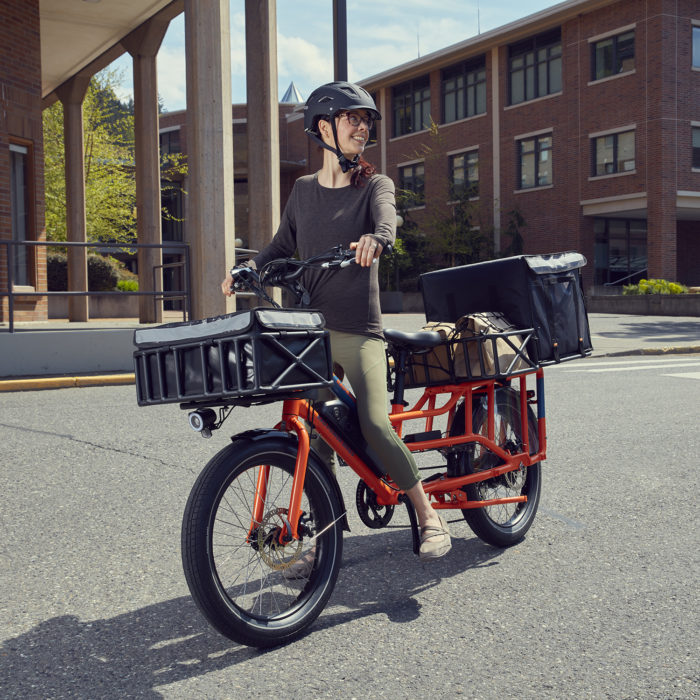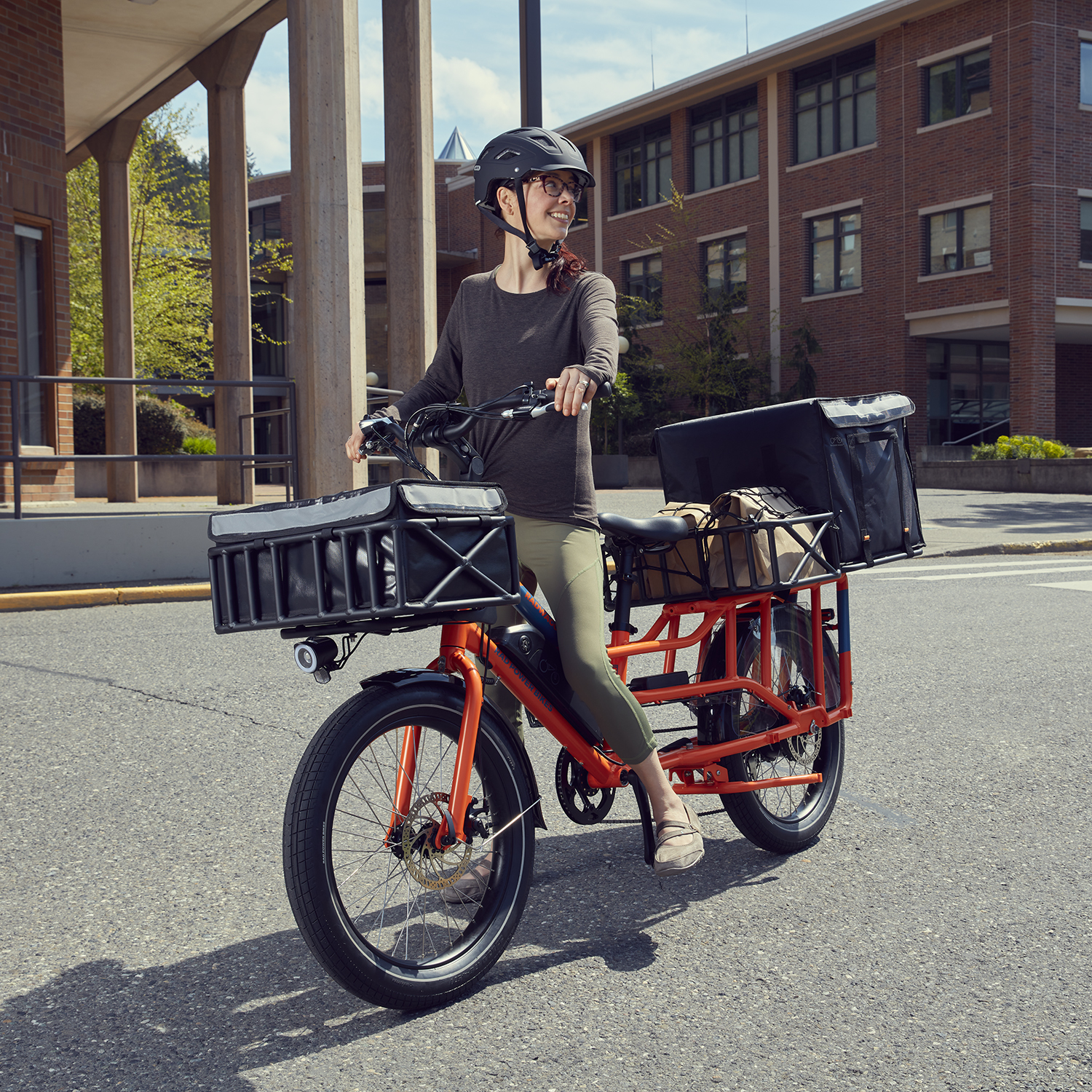
With the support of VertueLab, I’m examining what a carbon-free economy would look like. This is Part 1 in the series.
Part 1: Transportation
Part 2: Power
Part 3: The Built Environment
Part 4: Restoration
If we’re going to get a handle on climate change, American transportation needs to transform. Our cars and trucks cough out 28 percent of U.S. carbon emissions — more than any other sector. And, we’ve been warned by the world’s best climate scientists, we’ve got about three decades to cut our auto emissions from 1.88 billion metric tons a year to something in the neighborhood of zero.
I wanted a glimpse of the transportation future that — one hopes — awaits us, so I visited Seattle’s tony Ballard neighborhood to test drive an electric vehicle. It wasn’t a Tesla. And, come to think of it, “test drive” isn’t really the right term. I had come to the flagship showroom of Rad Power Bikes, a purveyor of electric bicycles, to ride a machine that, if we utilize it well, could accelerate our progress toward a carbon-free transportation sector.
It might seem like the bicycle-as-climate-savior argument is coming out of left field given that we use cars for, well, everything. Indeed, virtually every expert agrees that the biggest step we can take toward eliminating greenhouse gas emissions from the transportation sector is to electrify our vehicles. But while electrification might be the biggest step, it’s not the only one, nor is it the most challenging.
“It’s better to have an electric car than a fossil-fuel burning car. … That said, electrification totally misses the boat, because you’re just replacing a car with a car,” said Marc Schlossberg, professor of city and regional planning and co-director of the Sustainable Cities Institute at the University of Oregon. “If we’re really going to deal with climate change, the only feasible path forward is to reduce car dependency.”
In a report detailing what it would take to reduce America’s greenhouse gas emissions at least 80 percent by 2050, the United Nations’ Sustainable Development Solutions Network said electrification alone isn’t enough: we also must reduce per-capita vehicle use by a quarter. Doing that means we need a substitute for the car, and a variety of electric bike makers around the West provide just that.
“Electric bikes really break down the barriers — of distance, of time, of effort,” Pontus Malmberg, the founder of ebike maker Blix, told me.
I’m a dedicated bicycle commuter — a majority of my in-town trips occur via bike — but I still find myself turning to our Subaru on trips to Costco or a hardware store. Thus, I had my eye on the RadWagon, a utility bike with an extended rear rack that can hold 120 pounds of boxes, luggage, children — whatever you happen to be hauling. If the RadWagon could shuttle me and, say, a week’s worth of food around a hilly neighborhood, then I have to think ebikes like it could help many of us ditch our cars.
From our sponsor
No machine has shaped American life more than the automobile. Car companies and governments have engineered a society in which it’s commonplace to use a multi-thousand-dollar, multi-thousand-pound machine to accomplish even the most basic tasks. So it’s no surprise that transportation accounts for the largest share of American emissions. Our Camrys, F-150s, Suburbans, and other vehicles emit more greenhouse gases each year than Japan, Russia, or Germany.
But the true carbon footprint of our vehicles is much, much larger than their tailpipe emissions. “Even if most vehicles were powered by electricity and renewable hydrogen,” the Sustainable Development Solutions Network analysis states, “significant [greenhouse gas] emissions would be emitted in vehicle manufacturing and building and maintaining roads.”
Cars are the largest and fastest things most people own, so they require extensive resources, personal and public, to accommodate them. We widen traffic-choked highways to accommodate more and more cars. Huge swaths of our cities — entire lanes of streets, big parts of residential lots, the majority of many office parks — hold parked cars that sit empty and unused. The spatial productivity sacrificed to the automobile is immense, and the opportunity cost is steep. All those parking lots could be housing, parks, small businesses, and the like.
“Reducing the need for driving makes it possible to reduce the amount of driving we do and the myriad negative impacts that come with it: greenhouse gas emissions, air and water pollution, injuries and fatalities from crashes, wear-and-tear on the roads that is costly to repair, ambient noise levels, and the stress of driving in congested conditions, among others,” writes Susan Handy, a professor at the University of California, Davis Institute of Transportation Studies.
Fortunately, there’s a way out. And it has two wheels.
•••
Just as cars have cascading ramifications, the perks of widespread cycling compound upon one another. The obvious one, when it comes to climate change: bikes are more efficient. Your typical car gets 36.3 passenger miles per gallon; by one measure, bicycles get a mind-boggling 984 passenger miles per gallon, and ebikes could be even more efficient. Even if those estimates are way off, bicycles are almost certainly the most efficient form of mobility, and their widespread adoption could cause direct emissions from transportation to plummet. Researchers at UC Davis estimate that if the world’s city-dwellers were to embrace transit and make 23 percent of trips via bicycle (up from 6 percent today), emissions from global urban transportation would be more than 2 gigatons lower by 2050 compared with a business-as-usual scenario. That’s like wiping every U.S. car off the road.
The tit-for-tat extends well beyond emissions. Cars are expensive: $9,200 per year to own and operate. Bikes are cheap: about $300 a year. Cars are unhealthy: driving equals sitting, traffic causes stress, tailpipe emissions foul the air. The health benefits of riding a bicycle are obvious. Cars kill people: 36,000 Americans die in traffic accidents each year. Bikes rarely do: in the rare instance somebody dies on a bike, they’re usually hit by a car. Cars are exclusive: young people and many senior citizens are legally unable to drive. Bikes are accessible: if you can balance and pedal, you can ride one.
For those looking to shed a car, ebikes are even more accessible. Malmberg, Blix’s founder, grew up in Sweden, and was shocked by America’s car-obsessed culture when he moved to California in 2009. “Drive-thru ATMs were pretty incredible,” he said. To him, ebikes vastly expand the population for whom a bike is practical.
“They’re all about convenience,” Malmberg said. “You can cover longer distances, and go faster. You don’t sweat, and big hills aren’t as much of an effort. Sometimes, you can’t get up a hill — you literally don’t have the strength. An electric bike enables you to go places you otherwise couldn’t.” That message has resonated — Malmberg said Blix’s sales were up 300 percent in 2020, a year in which global bike sales skyrocketed.
To maximize bikeability, though, we need to change our streets. “Basically, on your busier streets, you need a connected system of protected bike lanes with physical barriers,” Schlossberg told me. “And then you complement that with a system of low-speed residential roads. And that’s it!”
Well, not quite, he clarified. To get more people on bikes, you have to make it more difficult and more expensive to drive a personal vehicle. To that end, researchers at UC Davis have some recommendations. Achieving a high-cycling scenario — the one in which we drop our 2050 emissions by 2 gigatons — means we need to repeal giveaways to vehicles like free street parking, subsidized fossil fuels, and minimum parking requirements in residential neighborhoods. In addition, congestion pricing and per-mile fees could fund pedestrian infrastructure, transit, and cycling programs, the authors wrote. Any electric vehicle subsidies should apply to ebikes, too.
(It’s no surprise that so much bicycle research emerges from Davis. About 22 percent of trips there are made by bike, by far the highest rate in the country. Next up is Boulder, Colorado, at 10 percent; the U.S. average is 1 percent.)
But why spend any time and money on bicycle initiatives if experts say electrifying vehicles is the more urgent need? That brings us to the final perk of bike-centric planning: it can make the process of electrification easier and faster. In a city with dense development, less parking, slower streets, and more pedestrians, EVs simply work better.
Electric delivery vehicles, like the ones Amazon and the U.S. Postal Service are introducing, are great fits for these short, slower trips. Public transit use would increase, creating an opening for electric buses like those made by California-based Proterra, which are already in use in Reno, Missoula, and other Western cities. Bike-ready streets open up the possibility for new visions of the automobile, too. Western startups like Utah-based Vanderhall and Oregon’s Arcimoto both make stripped-down electric vehicles that would play nicely with electric bikes cruising by. (Arcimoto is a portfolio company of VertueLab, this story’s sponsor.)
Ebikes, because of their practicality, could speed this transition to an all-electric, more pedestrian-friendly transportation system. Western firms are leading the electric bike renaissance, thanks in large part to their affordability. High-end ebikes from traditional bike brands can cost more than $5,000, but models from direct-to-consumer brands like Rad, Blix, Seattle-based Propella, and California’s Aventon typically cost less than $2,000. That’s not pocket change, but when you consider the $9,000-a-year figure Americans spend on their cars, the upfront price of an ebike is more palatable.
•••
Back in Seattle, I wasn’t able to make the grocery run I had envisioned — Rad’s showroom is mobbed on Saturdays, so I could only take the bikes out for 15 minutes at a time. Still, I was able to get a feel for their potential. The RadWagon cargo bike seems like one of the most practical, albeit not the best-looking, devices you can own. Aboard the 77-pound bike, I was able to breeze up a pretty steep hill with little effort, which bodes well if you have 150 pounds of cargo strapped to the rear rack. The woman who tested the bike before me had her young son sitting on the back. Crank up the pedal-assist motor, and you can hit 28 mph. The bike was easy to ride, relatively comfortable, has a 350-pound payload capacity, and can go 45 miles on a charge, the company says. Assuming one owns appropriate winter clothing, it seems the RadWagon could substitute for a car on most trips the average person takes.
After testing out three bikes, I sat at an adjacent brewery’s patio and watched dozens of cyclists — about a 60-40 split between middle-age folks and senior citizens — cruise by. I felt like I was seeing into the future, one dominated by ultra-practical, climate-friendly electric vehicles that are accessible to almost anybody.
From our sponsor

VertueLab is a nonprofit that provides funding and business support to climate tech entrepreneurs who are solving today’s biggest challenges. Donate to VertueLab today to have an impact on people and the planet.
Share with a friend | Watch a cat video | View previous newsletters


